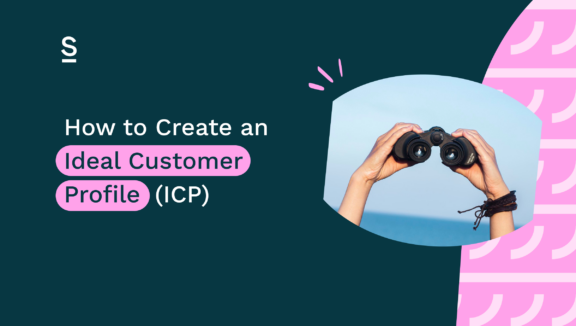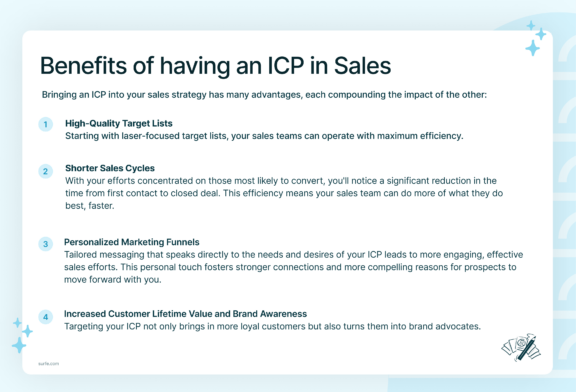How to Create an Ideal Customer Profile (ICP)

An Ideal Customer Profile is a concept of the best possible customer for your product or service. It’s designed to help you find people who will love what you sell and so are more likely to convert.
Without an ICP, you aren’t making smart pitches to people who might want what you’re selling – you’re just cold pitching and hoping for the best.
An ICP helps you have the best possible chance of converting a lead.
Key highlights:
Understanding Ideal Customer Profiles (ICP)
Your ICP is a detailed portrait of the company or customer who would get the most out of what you’re offering. This isn’t about casting a wide net; it’s about precision—focusing your efforts on the customers who are most likely to convert.
What is an ICP?
Understanding the traits of your ICP can transform your approach to sales. An ICP defines the perfect match for your product or service. It’s not just any company or customer; it’s the one that most aligns with what you provide that they are most likely to:
- Make a purchase and become a loyal customer
- Act as a champion for your brand, spreading the word to others like them
- Bring value back to your business through referrals or testimonials
The Benefits of Knowing Your ICP
Knowing who your ICP is doesn’t just give your sales team direction, it can influence your entire business model. Here’s how:
- Better use of your product or service: Your ICP is tailor-made to get the most out of what you offer, which means they’re more likely to see and demonstrate its value to others
- Time reduction: When you target more of the right customers, your sales efforts are more efficient and you can focus resources on leads that are more likely to convert
- Boosted productivity and staff morale: teams work better when they have clear goals and when their efforts lead to success. Targeting your ICP makes your teams’ work more effective, and more rewarding.

How ICPs can help bridge Sales and Marketing
Perhaps the most transformative benefit of an ICP is its ability to bring sales and marketing together. When both teams are aligned in who they’re targeting and why, they’re better able to support each other:
Both teams know who they’re targeting
With a shared understanding of the ICP, marketing efforts become more targeted and effective, directly feeding the sales pipeline with high-quality leads.
Both teams use the same language
Both sales and marketing have their own unique vocabularies. When both teams are on the same page with ICPs, it fosters a shared language and understanding, breaking down silos and promoting a cohesive approach to customer acquisition and retention.
Distinction Between ICP and Buyer Persona
As we refine our approach to building effective sales and marketing strategies, it’s crucial to clarify the distinction between two terms that are often used interchangeably but serve different purposes: the Ideal Customer Profile (ICP), and buyer personas. Understanding the nuances between these concepts is key to achieving better results.
Ideal Customer Profile (ICP)
The ICP hones in on the “perfect” customer, the most advantageous fit for your business. The ICP focuses on factors like industry, company size, budget, and location, painting a picture of the customer that would derive the most significant benefit from what you offer.
Buyer Personas
On the other hand, buyer personas are crafted from a blend of psychological and demographic data, aiming to encapsulate the varied individuals within your target market.
These personas delve into the minds and lives of potential buyers, considering their pain points, goals, personal demographics, and behavioral patterns. This detailed understanding helps tailor marketing and sales approaches to resonate on a more personal level, addressing specific needs and motivations of different segments within your audience.
Why Both ICPs and Buyer Personas matter in your sales strategy
It’s important to remember the difference between these two concepts.
Your ICP guides you to the customer segments that are most valuable to target, acting as a beacon for sales.
Buyer personas help in crafting the messaging and engagement strategies that will resonate best with those within your ICP, ensuring that your communications are as effective as possible, speaking to the person, not just their job role.
In essence, while your ICP outlines the “who” at a macro level, buyer personas dive into the “who” at a micro level, offering insights into how to approach and communicate with different individuals within those target organizations. Both are crucial for a nuanced sales strategy that makes an impact.
If you’re interested in learning more about buying groups, you might also enjoy these articles:
How to create an ICP for B2B
Here’s our step-by-step guide to creating an ICP for your business:
Step 1: Identify Super Users
Begin by taking a close look at your existing customer base to spot those who get the maximum benefits from your product or service. Consider factors like:
Industry fit: Is there a specific industry sector that seems to be a perfect match for your product?
Profitability and funding: Are these customers financially secure and likely to engage in a long-term relationship with your company?
Readiness to buy: How prepared are they to make a purchase?
Scalability: Do these customers have the potential for growth that your product or service can support?
Company size and geographical location: Do these factors align with your offering?
Step 2: Request Interviews
The next step is to interview these super users. These help you understand why they chose your product, how they are using it, and what benefits they’re experiencing. Focus on learning:
- The decision-making process and key influencers
- The initial discovery of your product or service
- The primary reasons for their purchase
- The tangible and intangible benefits they’ve gained
Step 3: Analyze Data
With the data from your interviews, you can start to look for patterns. What common characteristics do your super users share? Are there recurring themes in how they found you or why they chose you?
This analysis will start to form the backbone of your ICP by highlighting the attributes that your best customers share, and that you want to target in others.
Step 4: Create ICP Template
From here you can bring your findings together into an ICP template. This doesn’t need to be overly complex; include industry, size, location, and other important characteristics that define your super users.
Step 5: Refine Findings
Creating your ICP isn’t a one-and-done deal; it’s a living concept that evolves as your business and the needs of your customers change. Keep refining your ICP based on:
- Customer feedback: Listen to what your customers are saying.
- Website traffic analysis: Which content is attracting your ideal customers? Where are they coming from?
- Revenue data: Which customers are most profitable and loyal over time?
How to apply Your ICP in sales
Having crafted your Ideal Customer Profile (ICP), the next step is to put it into action.
With your ICP as your guide, it’s time to shape your sales efforts to reach out to these ideal customers. Here’s how you can leverage your ICP in sales:
Targeted Marketing Campaigns
Tailor your messaging, content, and promotional strategies to address the specific needs, pain points, and aspirations identified in your ICP. Ensure your campaigns strike a chord with the prospects most likely to convert.
Sales Outreach and Engagement
Arm your sales team with the insights from your ICP to fine-tune their pitch and communications. Understanding the industry, company size, and specific challenges of your ICP enables more meaningful conversations and connections.
Product Development and Innovation
Use the characteristics of your ICP to influence future product updates and innovations. By keeping your ideal customer at the heart of product decisions, you ensure your offerings remain closely aligned with their evolving needs.
Customer Experience Optimization
Align your customer service and support initiatives with the preferences and expectations of your ICP. This alignment not only enhances customer satisfaction but also fosters loyalty and advocacy among your most valuable customers.
Once you’ve identify a lead that fits your ICP, add them to your CRM
The Surfe Chrome extension allows you to add LinkedIn contacts to your CRM, along with all of their data, in one click, without ever leaving LinkedIn.
FAQs about Ideal Customer Profiles (ICP)
How frequently should an ICP be reviewed or updated?
Your ICP should be a living document that evolves alongside your business and market conditions. A general rule of thumb is to review and potentially update your ICP annually, or whenever there are significant changes in your market, product offerings, or business objectives.
Regular reviews ensure your ICP remains aligned with your current business strategy and the dynamic nature of the market.
Can a business have more than one ICP?
Yes, it’s possible and sometimes necessary for businesses operating in multiple markets or offering a range of products and services to have multiple ICPs. Each ICP should cater to distinct customer segments or industries, enabling targeted marketing and sales strategies that resonate with the specific needs of each group.
How do you balance between targeting the ICP and exploring new markets?
Balancing focus on your ICP while exploring new markets requires a strategic approach. Dedicate a portion of your resources to nurturing and expanding within your ICP, while allocating a separate set of resources for research and experimentation in new markets. This dual approach allows you to maintain growth within your core market while exploring potential opportunities for expansion.
What are the most effective tools or software for analyzing customer data to define an ICP?
Various CRM platforms, data analytics tools, and customer insight software can be highly effective in analyzing customer data to define your ICP. Tools like Salesforce, HubSpot, and Google Analytics provide good functionalities for tracking customer interactions, behaviors, and trends, helping you gather the necessary data to inform your ICP.
How do you measure the success of marketing and sales strategies aligned with the ICP?
Success can be measured through key performance indicators (KPIs) such as conversion rates, customer acquisition costs, customer lifetime value, and retention rates. Tracking these metrics before and after aligning strategies with your ICP will give you a clear picture of its impact on your marketing and sales effectiveness. You should see a big improvement across these areas once your ICP is in place.
What are the best practices for integrating ICP insights across different departments?
To ensure ICP insights are integrated across departments, foster a culture of communication and collaboration. Regularly share ICP updates and insights through cross-departmental meetings, workshops, and shared documents. Encourage departments to apply these insights in their strategies, from product development to customer service, to maintain a cohesive approach to targeting and serving your ICP.
How do you address the challenge of limited data when starting to define an ICP?
When data is limited, start by leveraging any available customer interactions, feedback, and market research to begin forming your ICP. Small-scale surveys, interviews, and industry reports can also provide valuable insights. As your customer base grows, continuously refine your ICP with the additional data collected.
What role does competitor analysis play in defining or refining an ICP?
Competitor analysis is crucial in understanding the market landscape, identifying gaps in competitor offerings, and uncovering untapped opportunities you can explore. Insights from competitor analysis can inform adjustments to your ICP, helping you to differentiate your offering and better meet the needs of your target customers.
What strategies can be used to engage with potential customers who fit the ICP but are hesitant to convert?
Engage hesitant customers by demonstrating clear value and understanding their unique challenges and needs. Personalized communication, case studies, testimonials, and trial offers can be effective strategies. Additionally, seeking feedback on their hesitations can provide insights to adjust your approach and better address their concerns.


